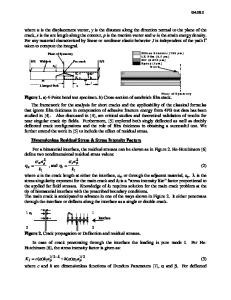A Novel Technique for Mixed-mode Thin Film Adhesion Measurement
- PDF / 937,466 Bytes
- 6 Pages / 612 x 792 pts (letter) Page_size
- 49 Downloads / 365 Views
Y3.5.1
A Novel Technique for Mixed-mode Thin Film Adhesion Measurement Junlan Wang, Nancy R. Sottos and Richard L. Weaver Department of Theoretical and Applied Mechanics, University of Illinois at Urbana-Champaign, 216 Talbot, 104 S. Wright, Urbana, IL 61801, USA.
ABSTRACT Guided by recent parametric studies of laser-induced tensile spallation, we successfully developed a new test method for studying mixed-mode interfacial failure of thin films. By allowing an initial longitudinal wave to mode convert at an oblique surface, a high amplitude shear wave is generated in a fused silica substrate and propagated toward the thin film surface. A shear wave was generated with amplitude large enough to fail an Al film/fused silica interface and the corresponding shear stress was calculated from high-speed interferometric displacement measurements. Examination of the interfaces failed under mixed-mode conditions revealed significant wrinkling and tearing of the film, in great contrast to blister patterns observed in similar Al films failed under tensile loading. Slightly higher interfacial strength was measured for the same Al film/fused silica substrate under mixed-mode loading than under tensile loading. The mixed-mode loading experiment developed in the current work provides a new tool to explore a range of thin film interfacial failure modes as well as the role of extrinsic effects such as residual stress, surface roughness, and imperfections.
INTRODUCTION Thin films are crucial components in a wide range of multiplayer microelectronic and optical devices. The size scales and dissimilar nature of the constituents present great challenges for thermo-mechanical integrity and reliability [1]. Interfacial adhesion is a critical parameter governing the mechanical behavior and performance of a thin film on a substrate. Significant effort has been devoted to the development of test procedures for the measurement of thin-film adhesion, of which the most common are the scratch, peel, pull, blister, and indentation tests [25]. During all these tests, the interface is subjected to very high stress levels and consequent inhomogeneous deformations. Large amounts of plastic deformation can result (especially in the peel test) and dominate the behavior during the test [6,7]. The stress fields are difficult to analyze and the resulting adhesion measurements tend to be qualitative and comparative. Vossen [8] introduced and Gupta and co-workers [9-14] later extended a laser spallation experiment to determine the intrinsic tensile strength of planar interface. This technique overcomes many of the inadequacies of the adhesion tests described above and can be used to determine the intrinsic interfacial strength. In laser spallation experiment, a high-energy laser pulse (duration on the order of nanoseconds) is absorbed by a thin metallic layer confined between a transparent backing and a substrate. Upon absorbing the laser energy, the sudden expansion of the confined layer generates a compressive stress wave directed towards the test film (
Data Loading...











